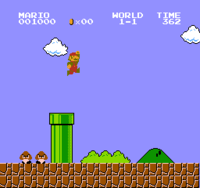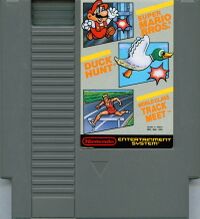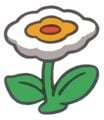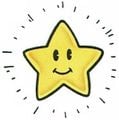Super Mario Bros.
Template:Articleabout Template:Infobox Super Mario Bros. (Japanese スーパーマリオブラザーズ Super Mario Brothers) is the semi-sequel to Mario Bros., a game which was released for the Famicom on September 13, 1985, and on the Nintendo Entertainment System in North America a month later, on November 11. This is the first game to be set explicitly in the Mushroom Kingdom, marking the first appearances of Bowser, Princess Toadstool, and Toad, as well as Koopa Troopas, Goombas and many other Mario series enemies. The game was also one of the eighteen Nintendo Entertainment System initial launch games. Super Mario Bros. was the best selling video game of all time until recently when it was surpassed by Wii Sports, and was largely responsible for the initial success of the Nintendo Entertainment System. As of 2003, the game has sold more than 40.23 million copies worldwide, making it the second best selling video game of all time.
Story
One day, King Bowser Koopa, the great and powerful leader of the militaristic Koopa Troop, invades the peaceful Mushroom Kingdom. He and his Koopa Troop are jealous of the beautiful kingdom, and King Bowser decides to take it for himself. To do this, Bowser casts an evil spell upon the kingdom and transforms all of its inhabitants into blocks, weeds, and other odd objects. It is foretold that only the Mushroom King's daughter Princess Toadstool can undo the spell. Knowing this, Bowser immediately kidnaps her. Fortunately, the heroic Mario Bros. learns about the Mushroom Kingdom's plight and they race to its rescue.
The player takes the role of Mario, or in the case of a second player, Mario's brother Luigi. The ultimate objective is to race through the worlds of the Mushroom Kingdom, evade or eliminate Bowser's forces, and save the Princess.[1].
Gameplay
Super Mario Bros. is divided into eight worlds, which each have four levels. Mario has to get to the end of the level by jumping over various gaps and avoiding the enemies on his way. Mario can use several platforms (some of them collapse when Mario lands on them), stairs in the level, as well as Jumping Boards. There are also pipes along the way, some of which Mario can enter to visit various coin rooms before returning to the level, a bit further ahead than when he left.
Enemies include Goombas, Koopa Troopas, Buzzy Beetles, Koopa Paratroopas, Bullet Bills, Hammer Bros., and jumping Cheep-Cheeps. All these enemies can be defeated when Mario jumps on them. Koopa Troopas and Buzzy Beetles will cower in their shell when jumped on, which Mario can kick to defeat other enemies with. Koopa Paratroopas will also lose their wings and fall to the ground when Mario jumps on them. Other enemies include Piranha Plants, the Spiny-throwing Lakitus and the Hammer Bros. These enemies are hard to defeat, and Mario has to either shoot fireballs at them or just avoid them. There are a few levels which take place underwater. In the water, Mario can swim freely from the top to the bottom of the screen. The enemies in underwater levels are Bloobers and Cheep-Cheeps. Mario can only defeat these creatures by shooting them with fireballs.
If Small Mario takes a hit, falls down a pit, or if the Time Limit runs out, he loses a life, and restarts the level. The point where Mario continues depends on how far he ran through the level before dying; either from the very beginning, or at one of several invisible "checkpoints" throughout the level.

Mario can get special power-ups out of ? Blocks or, uncommonly, Brick Blocks. Most of the ? Blocks in which Mario can find these items are visible, but some are hidden and only become visible when Mario hits them from beneath. With the Super Mushroom, he turns into Super Mario. As Super Mario, he can survive the hit of an enemy one time, at the cost of turning back to Small Mario. He may also destroy empty Brick Blocks by jumping beneath them. Additionally, he can also get the Fire Flower. With the Fire Flower, Super Mario turns into Fire Mario, which allows him to shoot fireballs at enemies to defeat them from a distance. With the 1-Up Mushroom, he gains an additional life; he can also get an extra life if he collects 100 coins. With the Starman, which can only be found in Brick Blocks, Mario turns invincible for a short amount of time, and can defeat enemies by simply touching them.
At the end of each level, there is a castle with a flagpole nearby. When Mario reaches the flagpole, he takes down Bowser's flag and enters the castle, completing the level. The higher the spot that Mario hits the flagpole, the more points he receives. If there are two players playing the game, Luigi's turn comes whenever Mario loses a life. Luigi has no special abilities in the game that are different from Mario's.
The fourth level of each world plays inside a castle. They are usually filled with Firebars, and Podoboos. At the end of a castle level, Mario is confronted with a False Bowser in Worlds 1 - 7 and the real Bowser in World 8. Mario ordinarily has no way to hurt Bowser, and has to either use the Ax to destroy the bridge, causing either the false Bowser or the real Bowser to fall into the lava, or pelt Bowser with a number of fireballs, which produces the same result and reveals the true forms of the fakes. After defeating a false Bowser, Mario frees several Toads from the castle, at which point they say their iconic sentence: "Thank you, Mario! But our princess is in another castle...". At the end of the castle in World 8, Mario frees the grateful Princess Toadstool and completes his adventure.
Hard Mode
After beating the game, the player is given the option to start the game again in Hard Mode, where all Goombas are replaced by Buzzy Beetles, and all enemies walk faster; all of the elevator-style lifts are about sixty-percent of their original size, while Firebars appear in all possible locations. Additionally, the music is slightly faster. However, the player still has the same amount of time to complete each level. The Mario Bros. gain no special powers in Hard Mode, and they receive no extra points when they defeat an enemy. The story remains exactly the same, as each of the first seven castles contain a Mushroom Retainer that needs rescuing, while the eighth castle has Princess Toadstool. If the player finishes the game on Hard Mode, he or she will unlock nothing new from the previous time the game was finished.
Items
Super Mario Bros. introduced some elements that made subsequent appearances in later Mario games:
| Coin | If Mario or Luigi manage to collect 100 of them, he will receive an extra life (1-Up). | |
| Super Mushroom | When one of the Mario Bros. eat one of these, he will turn into their Super form. | |
| Fire Flower | This flower grants the Mario Bros. the ability to shoot fireballs. | |
| 1-Up Mushroom | A rare item; once collected, it grants the Mario Bros. an extra life. | |
| Starman | Makes the Mario Bros. invincible for a short amount of time. |
Power-Ups
| Small Mario | An 8-bit Mario in the Mini-Form. When he gets hit by an enemy, he gets defeated. | |
| Small Fire Mario | Glitched version of Fire Mario, when hit, Mario becomes Super Mario, when Super Mario gets Mushroom, Mario becomes small Mario, but if Super Mario gets hit, he loses a life. | |
| Super Mario | Mario turns into Super Mario by ingesting a Super Mushroom. Mario gains the ability to easily break Brick Blocks in this state (which he will not lose, even if upgraded further). When he gets hit by an enemy, he shrinks back to Small Mario. | |
| Fire Mario | After getting a Fire Flower, Super Mario turns into Fire Mario, giving him the ability to throw fireballs on the enemies (except stronger enemies). When he gets hit by an enemy, he reverts to Small Mario. | |
| Invincible Mario | After getting a Starman, Mario will become invincible, and he can defeat any enemy. It will only last for a short period of time and he still gets defeated when he falls into an abyss. |
Characters
Playable
Non-Playable
Enemies
- Blooper
- Bill Blaster
- Bullet Bill
- Buzzy Beetle
- Cheep-Cheep
- Firebar
- Goomba
- Hammer Bro.
- Koopa Paratroopa
- Koopa Troopa
- Lakitu
- Piranha Plant
- Podoboo
- Spiny
- Spiny Egg
Bosses
List of Levels
| World | Level | Setting | Enemies found |
|---|---|---|---|
| World 1 | 1 | Ground | Goomba, Koopa Troopa |
| 2 | Underground | Goomba, Koopa Troopa, Piranha Plant | |
| 3 | Heights | Goomba, Koopa Troopa, Koopa Paratroopa | |
| 4 | Castle | Firebar, False Bowser (Goomba) | |
| World 2 | 1 | Ground | Goomba, Koopa Troopa, Koopa Paratroopa, Piranha Plant |
| 2 | Underwater | Bloober, Cheep-Cheep, Piranha Plant | |
| 3 | Seaside | Jumping Cheep-Cheep | |
| 4 | Castle | Firebar, Podoboo, False Bowser (Koopa Troopa) | |
| World 3 | 1 | Ground | Goomba, Koopa Troopa, Koopa Paratroopa, Piranha Plant, Hammer Bro. |
| 2 | Ground | Goomba, Koopa Troopa, Koopa Paratroopa, Piranha Plant | |
| 3 | Heights | Goomba, Koopa Troopa, Koopa Paratroopa | |
| 4 | Castle | Firebar, Podoboo, False Bowser (Buzzy Beetle) | |
| World 4 | 1 | Ground | Piranha Plant, Lakitu, Spiny |
| 2 | Underground | Goomba, Koopa Troopa, Piranha Plant, Buzzy Beetle | |
| 3 | Heights | Koopa Troopa, Koopa Paratroopa | |
| 4 | Castle | Piranha Plant, Podoboo, Firebar, False Bowser (Spiny) | |
| World 5 | 1 | Ground | Goomba, Koopa Troopa, Koopa Paratroopa, Piranha Plant, Bullet Bill |
| 2 | Ground/Underwater (secret) | Goomba, Koopa Troopa, Koopa Paratroopa, Piranha Plant, Buzzy Beetle, Bullet Bill, Hammer Bro. (Bloober, Cheep-Cheep) | |
| 3 | Heights | Goomba, Koopa Troopa, Koopa Paratroopa, Bullet Bill | |
| 4 | Castle | Podoboo, Firebar, False Bowser (Lakitu) | |
| World 6 | 1 | Ground | Piranha Plant, Lakitu, Spiny |
| 2 | Ground/Underwater (secret) | Goomba, Koopa Troopa, Koopa Paratroopa, Piranha Plant, Buzzy Beetle (Bloober, Cheep-Cheep) | |
| 3 | Heights | Bullet Bill | |
| 4 | Castle | Podoboo, Firebar, False Bowser (Bloober) | |
| World 7 | 1 | Ground | Koopa Troopa, Koopa Paratroopa, Piranha Plant, Buzzy Beetle, Hammer Bro., Bullet Bill |
| 2 | Underwater | Bloober, Cheep-Cheep, Piranha Plant | |
| 3 | Seaside | Jumping Cheep-Cheep, Koopa Troopa, Koopa Paratroopa | |
| 4 | Castle | Podoboo, Firebar, False Bowser (Hammer Bro.) | |
| World 8 | 1 | Ground | Goomba, Koopa Troopa, Koopa Paratroopa, Piranha Plant, Buzzy Beetle |
| 2 | Ground | Goomba, Koopa Paratroopa, Piranha Plant, Buzzy Beetle, Lakitu, Spiny, Bullet Bill | |
| 3 | Near the castle | Koopa Troopa, Koopa Paratroopa, Piranha Plant, Bullet Bill, Hammer Bro. | |
| 4 | Castle/Underwater | Goomba, Koopa Paratroopa, Piranha Plant, Firebar, Podoboo, Buzzy Beetle, Hammer Bro., Bloober, Cheep-Cheep, Bowser |
Glitches
- Main article: Super Mario Bros./Glitches
Development
Super Mario Bros. was developed at the same time as The Legend of Zelda, both games by Shigeru Miyamoto, Takashi Tezuke, Toshihiko Nakago, Koji Kondo, the composer, Kazuaki Morita and Yasunari Nishida, two programmers, and Hiroshi Yamauchi, the executive producer.
According to the developers, some aspects in Super Mario Bros. was taken from The Legend of Zelda; firebars were one example, as they were present in the castles in The Legend of Zelda. Miyamoto implemented Firebars into Super Mario Bros. as an obstacle.
The main goal of Super Mario Bros. was to have a character travel through many lands with all different themes to each other and it would feature a diverse terrain, such as land, water, and sky. They intended for the main character to be twice the size of the final one.
In the beginning of developing the game, Mario wasn't supposed to be a playable character from the start. Instead, the players would have to control a 16 X 32 pixel square. The square couldn't even jump and as a result, Tezuka made Mario the playable character instead of the square.
Nakago and his team, Systems Research and Development (SRD), colored the background blue in some levels. This was unusual, because video games released during this time period usually had a black background, to avoid eye-strain and to avoid getting distracted by the bright colors. After coloring the background blue in some levels, Nakago then started designing maps for this game. First, Miyamoto and Tezuka would draw the levels on paper, and then Nakago and his team would design it into the video game and program it. Miyamoto wanted levels to last about a minute long and he told SRD to do so. He then realized that it usually takes about a second to travel across a screen, and that numerous of screens would have been implemented in one stage. SRD first thought that Miyamoto would request the them to make 60 screens per stage, but Miyamoto then explained that obstacles in each screen would slow down the player's progress, which resulted in an average of about 12 screens per level. The stage with the most screens has only 32, which is about half of what SRD has expected.
Nakago stated that a lot of documents were sent to them everyday to change some aspects of stages. Adjusting conditions in the stage was a tiresome job that is not present today because of the technology back then. Everyday, the group would do all they can do stated in the documents and until 10 at night, they would be done. By the next morning, they repeated the process.
Legacy
Reception
Super Mario Bros. received favorable reviews and considered one of the best games of all time. One of the most-praised aspects of the game is the precise controls in which players are able to control how far and high the characters jump and how fast they can run. The game popularized side scrolling video games, and the game received several sequels, followed by spin-offs, and many different ports and alternative versions. All characters, enemies and items found throughout the game have returned for following Mario games and the plot of Bowser kidnapping the princess has returned throughout the series.
The game was placed 14th in the 100th issue of Nintendo Power's "100 best Nintendo games of all time" in 1997.[2] It ranked the first spot in Electronic Gaming Monthly's "Greatest 200 Games of Their Time", named in IGN's top 100 games of all time lists in 2005 and 2007, and declared the second-best Mario game of all time. Super Mario Bros. has sold 40.24 million copies, being the best-selling Mario game and the second best-selling game of all time. It has received several other works such as a TV series based off it and movie.
References in Later Games
- Super Mario Bros. Special- A sequel created by Hudson.
- Super Mario Bros.: The Lost Levels- A direct sequel to Super Mario Bros. using many of the same sounds and sprites.
- Super Mario Bros. 3- Bowser returns along with the rest of the Koopa Troop, as well as elements from the original Super Mario Bros..
- All Night Nippon Super Mario Bros.- A remake of the '85 classic with elements that pertain to the radio program All Night Nippon replacing some of the original game's elements.
- Vs. Super Mario Bros.- This is a harder version of Super Mario Bros. for arcades.
- 2-in-1 Super Mario Bros./Duck Hunt- A re-release of the game which was bundled with the NES console in the NES Action Set. As the name suggests, the game was in a cartridge that also includes the Zapper Light Gun game, Duck Hunt.
- 3-in-1 Super Mario Bros./Duck Hunt/World Class Track Meet- Same as 2-in-1 Super Mario Bros./Duck Hunt, but as the title suggests, the cartridge also includes the game, World Class Track Meet. This bundle also includes the NES Power Pad that World Class Track Meet utilizes.
- Super Mario Bros. 2- The non-Japanese sequel to this game. Mushrooms, Starmen, and Koopa Shells appear.
- Super Mario Land- Mario's sprite in this game is near identical to his sprite from Super Mario Bros. Gameplay is also near identical.
- Alleyway- Several sprites from Super Mario Bros. appear in bonus levels.
- New Super Mario Bros.- Many things from Super Mario Bros. return here, such as- Flagpoles, Warp Zones (in the form of cannons). Also, a close-up of Mario from Super Mario Bros. as well as a picture from said game are unlockable backgrounds.
- Super Mario 64- Outside the Warp Pipe that leads to the final boss, carved into pillars are what look like sprites of Mario and Bowser from this game.
- Super Mario Sunshine - A castle level is seen when Mario first met F.L.U.D.D.
- Tetris DS - The first two levels were World 1-1, 3 and 7 were underground based, 8 and 9 are up in heights, and 10 was a castle.
- Super Smash Bros. Brawl- The stage Mushroomy Kingdom is based on worlds 1-1 and 1-2 of this game.
- Super Paper Mario - The sprites of Mario, Luigi, Peach, and Bowser appear around said character when they collect the Pill Pals. Also, when any character (including a Koopa Troopa) grabs a Mega Star, they turn into a huge version of their SMB sprites. (Mario and Luigi are their small forms in both.)
- Mario Superstar Baseball- The loading screen has Mario hitting a ? Block in graphics from Super Mario Bros..
- Wii Sports Resort- In Island Flyover, if the player flies by the Hillside Cabins, the Super Mario Bros. overworld and game over theme can be heard.
- Paper Mario: The Thousand Year Door - If the player jumps up in a vent and then comes down into the changing room in X-Naut Fortress then Mario and all his allies will become 8-bit and similar in style to the Super Mario Bros. sprites.
Alternate Versions, Re-releases
- 1985 - Original release (US/Japan)
- (Year Unknown) - Ported into the American arcade machine, the Nintendo Playchoice-10.
- 1986 - Re-released on the Famicom Disk System in Japan.
- 1986 - Game & Watch title.
- 1986 - Released in arcades as VS Super Mario Bros.
- 1988 - Re-released on the NES in the US as part of the 2-in-1 Super Mario Bros./Duck Hunt compilation, packaged with the NES Action Set.
- 1990 - Re-released on the NES in the US as part of the 3-in-1 Super Mario Bros./Duck Hunt/World Class Track Meet compilation, packaged with the NES Power Set.
- 1993 - Remake available on the SNES as part of the Super Mario All-Stars compilation (known as Super Mario Collection in Japan). Graphics and sound were updated, and many glitches were removed.
- 1994 - Remake available on the SNES in the US as part of the Super Mario All-Stars + Super Mario World compilation, packaged with the SNES Mario Set.
- 1998 - Remake released on the Game Boy Color as Super Mario Bros. Deluxe. The game featured the original game's graphics but loads of additional content.
- 2001 - The original game is available as an unlockable NES game in Animal Crossing. Unfortunately, it can currently only be unlocked using an Action Replay cheat.
- 2004 - The original game was re-released on the Game Boy Advance as part of the NES Classics / Famicom Mini collection, celebrating 20 years of the Famicom in Japan.
- 2006 - Available on the Wii as part of the Virtual Console.
- 2008 - Available in Super Smash Bros. Brawl as a playable demo.
- 2010 - 16-bit remake released with Super Mario All-Stars 25th Anniversary Edition.
- 2010 - Virtual Console remake with the "?s" on ? Blocks replaced with "25", exclusively bundled with a special, red wii.
Official Artwork
- Super Mario Bros JAP cover.jpg
Japanese box art - SMB Boxart.PNG
American box art - SuperMarioBrosBoxEU.PNG
European box art (based on Japanese design) Artwork used for the Japanese and sometimes European box, depicting most characters. This artwork is reused in Super Smash Bros. Brawl and Super Mario 64 DS. - SMBlogo.gif
The game logo (on the title screen)
- Mario SMB.png
- Super Mario Running Artwork.jpg
Mario running - BowserSMB1.PNG
- SMB Goomba.jpg
- KoopaPara SMB.png
- SMB BuzzyBeetle.jpg
- SMB BulletBill.jpg
- CheepCheepSMB.jpg
Trivia
- The Super Mario Bros. Deluxe manual and the the Virtual Console page of this game state that Koopas used black magic to aid their conquest of the Mushroom Kingdom, though the only other occurrences of this is by the Koopalings in Super Mario Bros. 3 and Bowser in Paper Mario (with the aid of the Star Rod) and in Mario Party.
- This game was originally supposed to be updated and packaged with Super Mario Advance, which would mean its sequels would have had the same side game.
- Super Mario Advance 4: Super Mario Bros. 3 had Classic World 1-1, 1-2, 1-3, 1-4, and 2-2. Only World 1-1 was released outside Japan.
- The Super Mario Bros. Stamps set was released in Japan at the end of May, 2007. The stamps feature sprites of characters and items from this game.
- If the player manages to get 128 or more lives, he or she will receive an instant Game Over should he or she dies again. The game somehow interprets this as the player having a negative amount of lives; this is likely due to data overflow.
- In order to differentiate the Goomba from the Super Mushroom to new players, and teach them that Super Mushrooms were a positive thing in the game, the developers designed the very first portion of World 1-1 so the player would stomp the incoming "menacing" Goomba instinctively and later reveal the Super Mushroom inside the ? Block. Since the Super Mushroom resembles the Goomba, the player would think it is another enemy and so jumps over it again to stomp it. Doing this leads to the transformation from Small Mario to Super Mario.
- On the Wii Shop Channel, the loading screen for downloading any title is Mario or Luigi hitting Brick Blocks and collecting Coins, sometimes with a Fire Flower.
References
- ^ Super Mario Bros. game manual, page 2
- ^ http://www.gamekult.com/communaute/forum/voirmessage.html?foid=13000909, retrieved 6/4/2009
Template:Super Mario Bros.
Template:Mariogames








